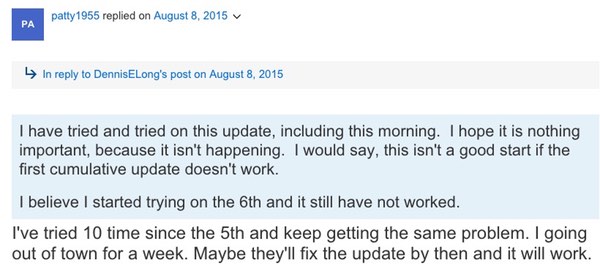 As ZDNet reports, some Windows 10 users have found themselves in possession of a continually rebooting computer after their PC downloaded a buggy cumulative update from Microsoft.
As ZDNet reports, some Windows 10 users have found themselves in possession of a continually rebooting computer after their PC downloaded a buggy cumulative update from Microsoft.
The problem appears to be in KB3081424, a cumulative update from Microsoft that was supposed to “enhance the functionality of Windows 10”, and patch a number of issues.
Irony of ironies, the patch is causing – for some at least – more serious problems than it appears to have been designed to resolve, with users thrown into an endless loop of crash, reboot, crash…

According to reports, some users have described that a quick fiddle in their Registry settings has resolved the issue, and allowed the update to install properly. However, that isn’t a solution that many users will feel comfortable with – and it may be wiser to hold off until Microsoft fixes the problem properly.
Of course, the problem is compounded by Microsoft’s insistence on making updates mandatory for home users, with no option to opt-out or wait and see whether they cause problems for others…
Don’t forget – there’s a reason why businesses don’t automatically roll out updates to thousands of computers, but instead take a softly-softly approach.
Large organisations are worried that a bad update might bork their network and stop users from being able to get on with their work, so they prefer to test updates on a small number of computers first, or wait a few days to see what other users report.
Microsoft had a noble aim with making security updates mandatory for home users of Windows, but there is always the danger that a buggy update will end up causing more problems than it aimed to fix.
And that’s why it’s right to give even home users an opt-out.



This is precisely why forced automatic updating is a bad idea. If you can't control your update process, you can't control your computer. If you can't control your computer, you can't control your productivity.
Handing such control of one's productivity over to Redmond is never a good idea in the first place, but given Microsoft's other Windows 10 SNAFUs (sharing WiFi passwords and the "WUDO Voodoo" fiasco), so far Windows 10 is shaping up to be another tragicomedy of errors.
Why is Microsoft always focussing on useless helping thoughts? If they really want to make it user friendly, then make it easy. User will do whatever they wanted to, but Microft did whatever they want in the name of user friendly. Why dont they just focuss on their OS security n not in their money making policy.
I never used to update my OS, as always, there is always something wrong after updates. Its better for Microsoft to replace all their programmers with a new one rather than putting users to frustrated and at risk.
I'm pretty sure that the Microsoft baby was dropped on its head severely retarding any and all intelligent growth within the organization, and as a result of not being able to formulate an intelligent thought they decided to just make it up as they go infuriating all in their path. Am beginning to think seriously about alternative OS
Of course if they tested these updates on there own computers then all should be well.
So why is this happening?
Would it be cheeky if I suggested that perhaps Microsoft uses Apple computers?
Wow, yet another "author" that published a copy & paste article and doesn't bother to do any research.
FROM THE ARTICLE:
"Of course, the problem is compounded by Microsoft's insistence on making updates mandatory for home users, with no option to opt-out or wait and see whether they cause problems for others…"
This statement is false. You can easily disable Windows Updates in the services console.
Either do some investigating or consult a knowledgeable IT person before publishing something like this in the future.
Perhaps you'd like to write an article describing how it is done, then? Alternatively you could refer to a document on Microsoft's website. Or is that beyond your capability? At this time it is nothing but criticism without any constructive feedback; your post is a perfect example of the opposite of a research (paper|post|whatever) – no citation whatsoever. People believe all sorts of things – even things that are so ridiculous and made up only to see just how gullible people can be – but the fact remains a lot of the things people believe is utter rubbish (often with overwhelming evidence that it is indeed not true). That's why those who want to be believed will back their statements up.
But the fact remains that even if it is POSSIBLE to opt-out it IS STILL A BRAIN DEAD IDEA (of many others) from Microsoft to EVEN CONSIDER AUTOMATIC UPDATES. Don't believe me? This article by Graham actually shows why.
Edit: Oh, and the services console. Most who use Windows wouldn’t want to deal with consoles. That’s why it is a GUI first and foremost. Additionally, saying where isn’t the same as saying how – your response is unhelpful criticism and nothing else. Also, as for being knowledgeable in IT. The first thing any knowledgeable person in IT would be aware of, is that users don’t like to have to workaround stupid designs, especially if it is via a console. Perhaps you’re not as experienced as you like to claim? That or you’ve never made an interface of any kind.
I'm done with Windows 10. failed 6 times (Yeah, 6, no kidding) when installing and failed to boot to startup after finally able to install it perfectly. At first, it looks so freaking good, and I didn't regret upgrading to Windows 10 from Windows 7. I just love the UI. When the bluescreen kept appearing after I try to restart my laptop, it drove me crazy so I decide to rollback to Windows 7. The fact about Microsoft launching this Windows 10 make me thinking, why are they throwing the Windows 10 upgrade, make people have to waste time on upgrading but failed to work as it should be. I'll stay with my Windows 7 for now, till they fix the hassle on upgrading and experiencing buggy Windows 10. What a waste of time.
Hi installed windows 10 twice. it screwed my computer up. i ended up with a blank screen after an update. vista worked well for some at the beginning and then slow for a lot of people very slow.windows 10 on my computer very slow and buggy.I think Microsoft is heading for trouble forcing the home user to have automatic updates. and also i was shocked with the intrusive settings on invading my privacy. so when less buggy it will be a custom install on windows 10. so i can untick all those intrusive boxes.
My problem with W10 was to have an enforced update that had a crash loop, no actual safe mode – you have to crash a bunch of times to be able to get the option – and then reverting to W7 basically ate the drive. Whole OS wiped out. YAY.
Fresh reinstall of W10 has mostly been stable, with the exception of the occasional bluescreen and weird standby modes of USB devices where some are still powered in sleep mode.